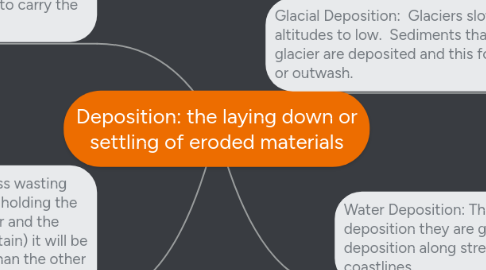Deposition: the laying down or settling of eroded materials
by Tatum Talboo


1. Wind Deposition: Common windblown deposits are dunes and loess. They form when wind slows down and loses the energy it needs to carry the sand.
1.1. Vocabulary: Dune is a pile of windblown sand and a loess is a crumbly windblown deposit of silt and clay
2. Deposition by Mass Wasting: Erosion that takes place during mass wasting continues as long as gravity is not stronger than the other forces holding the rock and/or soil in place. When the other forces become stronger and the material reaches a steady place (For example the base of a mountain) it will be deposited. It gets to this steady place when gravity is stronger than the other forces.
2.1. Vocabulary: A talus is a pile of angular rocks and sediments that form from a rock fall.
3. Water Deposition: There are 3 types of water deposition they are groundwater deposition, deposition along streams and deposition along coastlines.
3.1. Groundwater Deposition: Many structures in caves are formed from groundwater deposition. This is because dripping groundwater deposits minerals into caves that form structures such as Stalactites and Stalagmites.
3.1.1. Vocabulary: Stalactites are like icicles that form on cave ceilings from dripping groundwater with sediments in it.. Stalagmites form are structures that build up on cave floors from dripping groundwater with sediments.
3.2. Deposition Along Coasts: Much of the sand on ocean beaches were previously deposited from rivers. Long shore currents carry sand along the beaches. The san gets deposited because the currents that are slower have less energy and cannot carry the sand so it is deposited.
3.2.1. Vocabulary: Longshore currents are currents that flow parallel to the shoreline and often carry a lot of sediment.
3.3. Deposition Along Streams: Anywhere where water speed is decreased in a stream, deposition is happening. The slower moving water with less energy deposits sediments in meanders and deposits sediments when is reaches flat water/land and forms something like a delta.
3.3.1. Vocabulary: A delta is a large deposit of sediment which forms when streams enter large bodies of water.

